In the energy sector, safety and reliability are paramount, especially in power plants where high voltage systems are prevalent. One of the critical components that ensure electrical safety and system reliability is the earthing system. Copper bonded earthing rods are widely used in power plants due to their superior conductivity, durability, and resistance to corrosion. This article explores why these rods are essential for the effective operation of power plants.
1. Enhanced Electrical Conductivity
Copper is known for its excellent electrical conductivity, which is a crucial characteristic for earthing rods. Copper bonded earthing rods combine a steel core with a layer of copper, providing high conductivity while maintaining strength. This feature ensures that the electrical faults or surges are effectively diverted into the ground, minimizing the risk of equipment damage and enhancing overall system safety.
2. Corrosion Resistance
Power plants often operate in harsh environments that can lead to rapid corrosion of electrical components. Copper bonded earthing rods are designed to resist corrosion due to their copper coating, which protects the underlying steel from environmental factors such as moisture, chemicals, and soil conditions. This corrosion resistance extends the lifespan of the earthing rods, ensuring long-term reliability and reducing the need for frequent replacements.
3. Improved Grounding Resistance
Effective grounding is essential in power plants to ensure that electrical systems operate safely. Copper bonded earthing rods provide lower ground resistance compared to traditional earthing methods. Lower resistance allows for a more efficient path for fault currents, ensuring that electrical surges are quickly dissipated into the ground. This efficiency is crucial for protecting both equipment and personnel in the event of an electrical fault.
4. Versatility and Adaptability
Copper bonded earthing rods can be used in various applications within power plants, including substation grounding, generator grounding, and transformer grounding. Their versatility allows power plants to implement a standardized earthing solution across different systems, simplifying installation and maintenance procedures. Additionally, they can be easily adapted to meet the specific grounding requirements of different equipment.
5. Compliance with Safety Standards
Power plants are subject to strict safety regulations and standards. The use of copper bonded earthing rods helps facilities comply with national and international safety standards, such as those set by the IEEE and NEC. These standards mandate effective grounding systems to ensure the safety of personnel and equipment. By using copper bonded rods, power plants can demonstrate their commitment to adhering to these regulations.
6. Reduced Risk of Electrical Hazards
Electrical hazards, such as electrocution and fires, pose significant risks in power plants. Copper bonded earthing rods play a crucial role in minimizing these risks. By providing a reliable path for fault currents to flow safely into the ground, these rods help prevent dangerous voltage build-up that could lead to electrical shocks or fires. This increased safety is essential for protecting personnel and maintaining operational continuity.
7. Cost-Effectiveness
While the initial investment in copper bonded earthing rods may be higher than traditional earthing solutions, their long-term benefits outweigh the costs. The durability and corrosion resistance of these rods reduce the need for frequent replacements and maintenance, resulting in lower lifetime costs. Additionally, their efficiency in fault current dissipation can help prevent costly equipment damage, further enhancing their cost-effectiveness.
8. Environmental Considerations
As sustainability becomes increasingly important in the energy sector, the environmental impact of electrical components is under scrutiny. Copper bonded earthing rods are manufactured using recyclable materials, aligning with the industry's push towards greener practices. By choosing environmentally friendly earthing solutions, power plants can contribute to sustainability initiatives while maintaining safety and reliability.
9. Facilitating System Performance
An efficient earthing system is essential for the optimal performance of electrical systems in power plants. Copper bonded earthing rods help minimize voltage spikes and transients, contributing to the overall stability of the electrical network. This stability is vital for ensuring the smooth operation of generators, transformers, and other critical equipment, ultimately leading to improved power quality and reliability.
10. Future-Proofing Electrical Systems
As power plants evolve to incorporate new technologies and renewable energy sources, the need for robust earthing solutions becomes even more critical. Copper bonded earthing rods can accommodate the increasing complexity and demands of modern electrical systems. Their adaptability and durability position them as a reliable choice for future-proofing power plant earthing systems.
Conclusion
Copper bonded earthing rods are essential components in power plants, providing enhanced electrical conductivity, corrosion resistance, and improved grounding performance. Their role in minimizing electrical hazards, ensuring compliance with safety standards, and facilitating system performance makes them indispensable in the energy sector. By investing in high-quality copper bonded earthing rods, power plants can enhance safety, reliability, and operational efficiency while contributing to sustainability initiatives. As the industry continues to evolve, these rods will remain a crucial element in the design and implementation of effective earthing systems.





